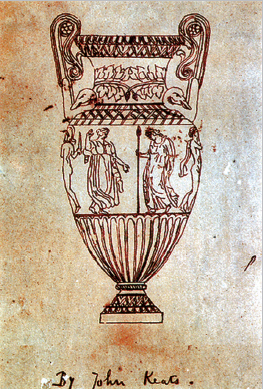MM1-a What does it mean to “read” a text?
These chapters ask you to take a new look at the act of reading. You know that a person can read an article, but can he “read” a painting? Someone can read a book, of course, but can she “read” a podcast? Your immediate answer might be “No, of course not!” but if you can rethink what it means to read—and consider that reading can mean taking a closer look or listening critically—your answer might be “Well, maybe!” These chapters also ask you to reconsider what is meant by the word text. Most people would call an essay or a poem a text. Can a movie soundtrack or a cartoon be called a text?
To dig into these terms, compare John Keats’s drawing in Figure 1-1, an ancient urn, with his 1819 poem “Ode on a Grecian Urn.” What are the characteristics that might lead us to call the drawing a text? What are the characteristics that might lead us to call the poem a text? How would we “read” the image of the urn? How do we “read” the poem?
Here is an excerpt from Keats’s “Ode on a Grecian Urn”:
O Attic shape! Fair attitude! with brede
Of marble men and maidens overwrought,
With forest branches and the trodden weed;
Thou, silent form, dost tease us out of thought
As doth eternity: Cold Pastoral!
When old age shall this generation waste,
Thou shalt remain, in midst of other woe
Than ours, a friend to man, to whom thou say’st,
“Beauty is truth, truth beauty,”—that is all
Ye know on earth, and all ye need to know.
If reading means discovering what a text is saying, it’s helpful to consider how the text is presenting its meaning. In the poem, meaning is presented through written words. The drawing shows details from the actual urn, including images that communicate meaning. Both “texts” tell a story for a purpose and to an audience.
Reading may also require careful attention to the historical and cultural context in which a text is created. A text always emerges out of a time and a place and a social situation. To read Keats’s poem effectively may require knowing something about the English Romantic literary movement. To read the image of the urn effectively may require a familiarity with the uses of urns and other pottery in ancient Greece.
Almost anything can be read—that is, carefully approached and analyzed for what it does and how it does what it does. Almost anything can be a text—that is, something that conveys meaning. Reading carefully and critically often means asking questions about a text. When and by whom was the text created? What purpose was it intended to serve? What assumptions does the creator or composer make about the audience? Reading for a college course requires active, thoughtful investigation.
